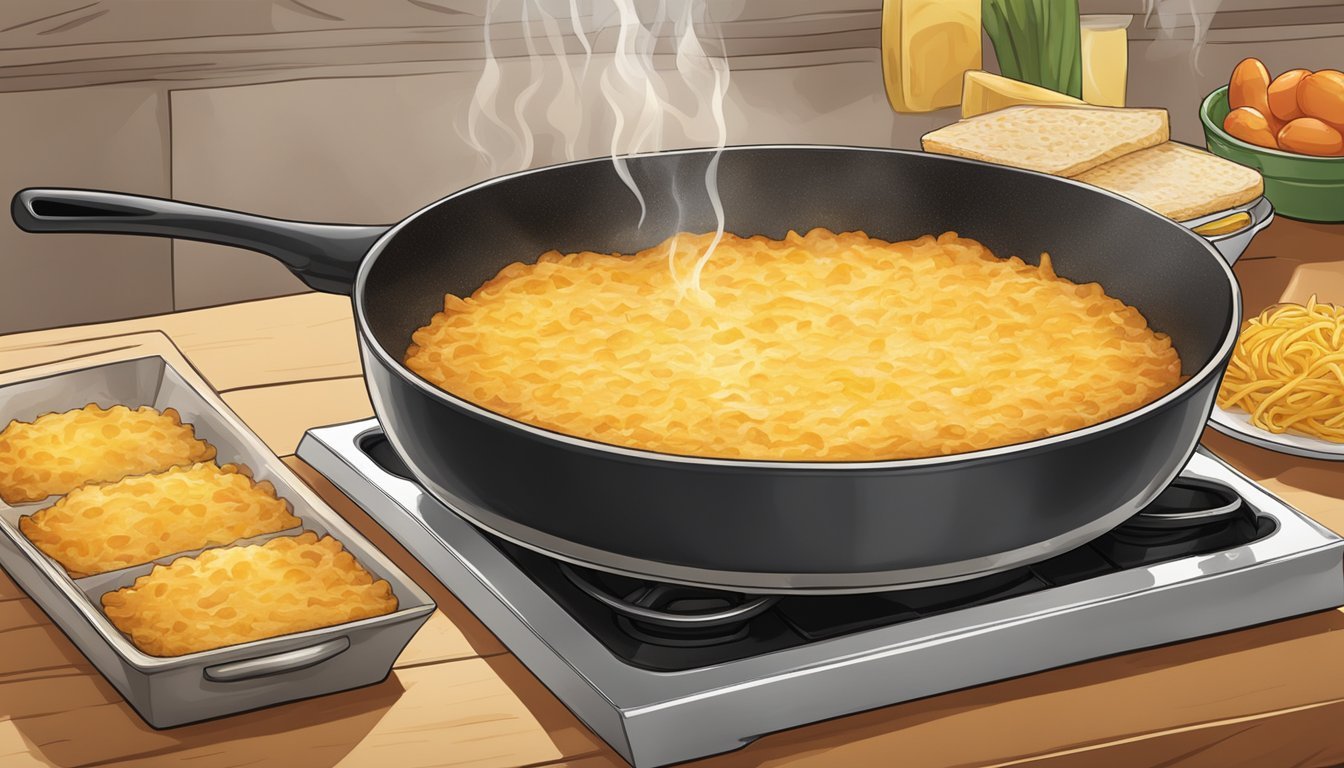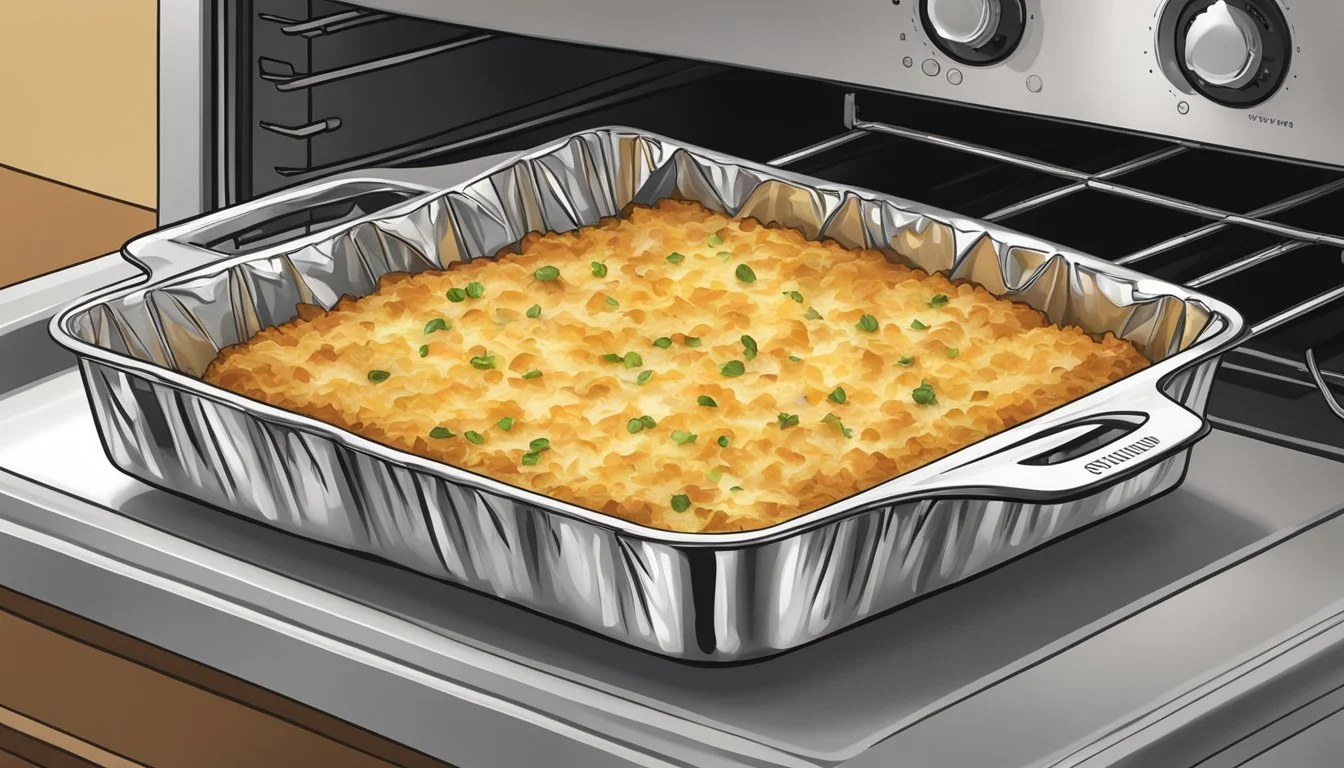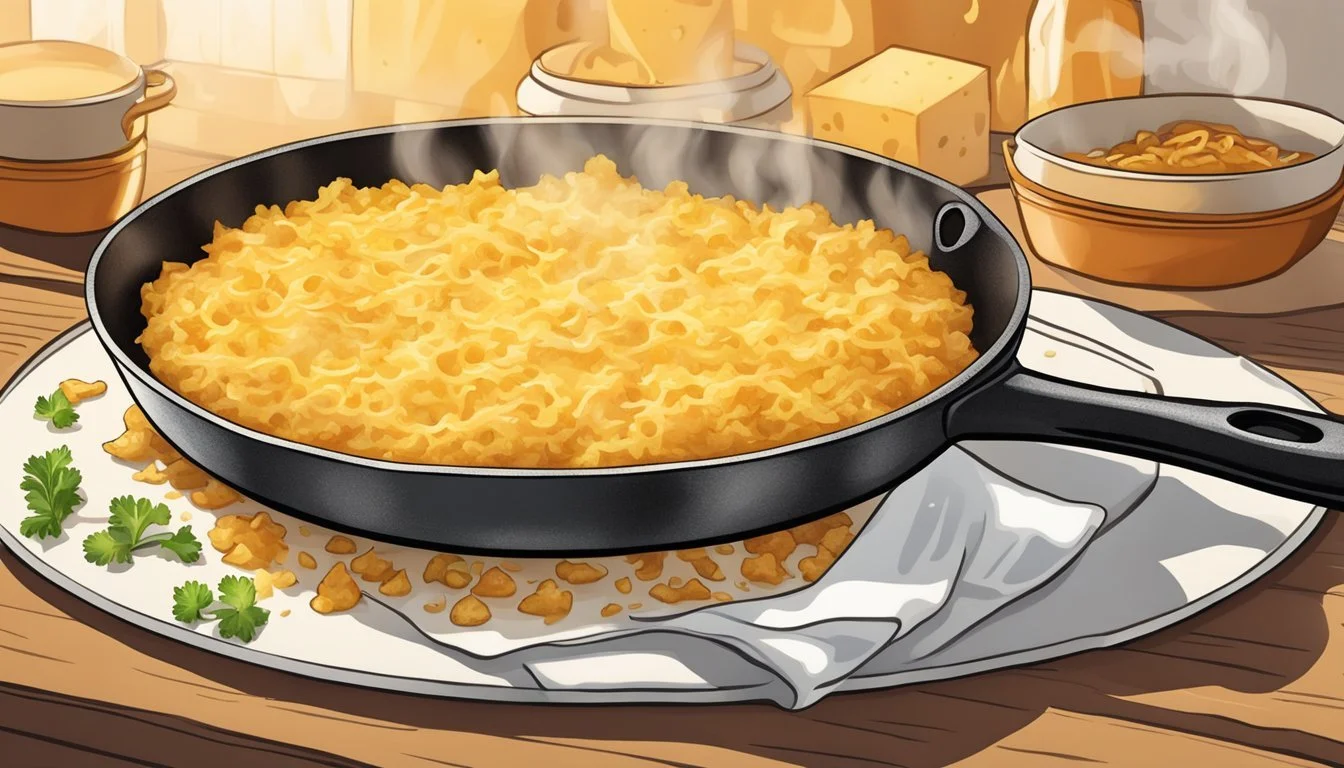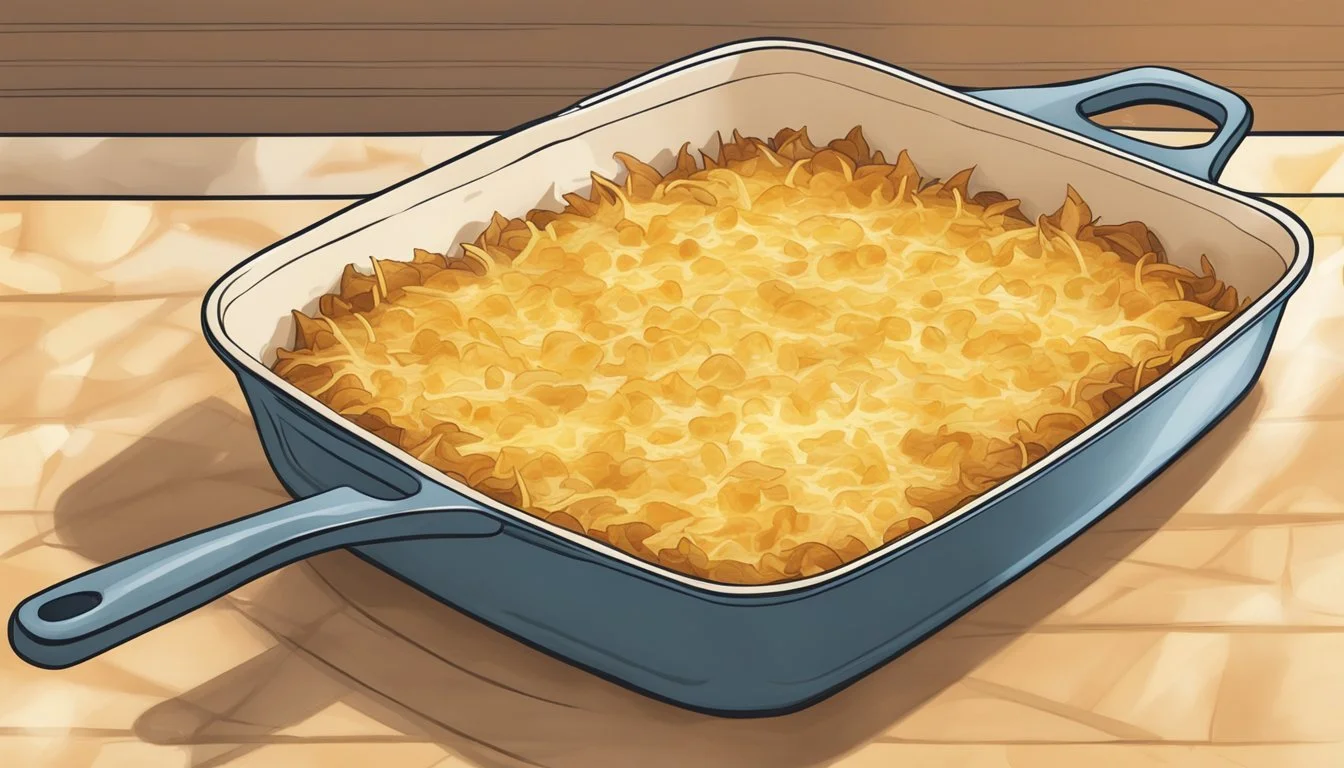Best Way to Reheat Hash Brown Casserole
Tips for Crispy, Cheesy Results
When reheating a hash brown casserole, the challenge is to restore its freshly-baked qualities: the golden, crispy exterior paired with a soft, cheesy inside. Achieving this balance is key to enjoying leftovers that are just as appetizing as when the casserole was first pulled from the oven. To ensure that the hash brown casserole retains its texture and flavor, there are several effective methods that can be utilized, each suited to different circumstances and kitchen setups.
Utilizing the oven to reheat the casserole is a widely recommended method, as it provides a consistent heat that warms the casserole thoroughly without sapping its moisture. Covering the dish with aluminum foil can prevent the top from burning, while allowing the interior to become hot and the cheese to melt properly. Meanwhile, for those seeking to recapture the casserole’s crispiness, a brief stint in a skillet on the stovetop can lend a desirable crunch to the dish’s surface. This method requires attentive stirring and a watchful eye to ensure even heating and to prevent the bottom from burning.
People often resort to the microwave for its convenience, but it has its drawbacks, such as a tendency to create a soggy texture. To circumvent this, reheating in intervals and flipping the casserole in between can result in a more even distribution of heat. Additionally, laying a paper towel over the dish can absorb excess moisture. Each reheating method has its own set of steps for success, lending the casserole distinct textures and qualities reflective of the chosen technique.
Understanding Hash Brown Casserole
Hash brown casserole is a versatile dish that can be a staple at breakfast, lunch (What wine goes well with lunch?), or dinner, offering the perfect combination of comfort food and convenience. It often includes a crispy potato base mixed with cheese, and it is known for its ability to be made ahead of time.
Key Ingredients
Hash Browns: Shredded potatoes that form the base of the casserole.
Cheese: Adds a rich, creamy texture and flavor; commonly used types include cheddar, Colby, and Monterey Jack.
Additional Binders: Ingredients like eggs or cream of chicken soup to bind the casserole together.
Popular Variations
Meats: Incorporation of meats such as bacon, ham, or sausage.
Vegetables: Addition of onions, peppers, or other vegetables for enhanced flavor and nutrition.
Toppings: Use of crispy toppings like crushed potato chips or panko breadcrumbs for additional texture.
Serving Suggestions
Hash brown casserole is best served hot, often enjoyed as:
Main Dish: A hearty breakfast option with eggs and toast.
Side Dish: Complements main courses at lunch or dinner, such as roasted meats.
Potluck: Ideal as a make-ahead dish for gatherings due to its easy reheating qualities.
Preparation Before Reheating
Proper preparation of hash brown casserole before reheating is crucial for maintaining its crispy texture and cheesy flavor. It begins with correct storage and defrosting methods that help preserve the dish's quality.
Storing Leftovers
To store leftover hash brown casserole in the fridge:
Cool Down: Allow the casserole to cool to avoid condensation before storing.
Wrap Tightly: Cover the dish with plastic wrap, pressing down to minimize air exposure.
Seal with Foil: Wrap the casserole dish further with aluminum foil for added protection.
Refrigerate: Place the wrapped casserole in the fridge, ideally at a temperature below 40°F.
In the freezer:
Cool Completely: Make sure the casserole is at room temperature before freezing.
Airtight Container: Use an airtight container to prevent freezer burn.
Layer of Protection: Add a layer of plastic wrap before sealing with the container's lid.
Freeze: Store in the freezer for up to 3 months for optimal quality.
Defrosting Frozen Casserole
To defrost frozen hash brown casserole:
Plan Ahead: Transfer the frozen casserole from the freezer to the fridge the night before intending to reheat, allowing it to thaw gradually.
Thawing Time: Ensure at least 24 hours for a complete and even thaw.
Room Temperature Option: For faster defrosting, place it on the counter for a few hours, but do not exceed 2 hours to prevent bacterial growth.
Reheating Techniques
When reheating hash brown casserole, one aims to maintain its crispiness and cheesy goodness. The technique chosen can make the difference between a satisfyingly crunchy bite and a soggy disappointment. The following methods offer various ways to achieve the desired outcome.
Oven Method
To reheat the casserole in the oven, they should preheat it to 350°F (175°C). It is ideal to place the hash brown casserole in a baking dish and cover it lightly with foil to promote even heat distribution. One should bake the dish for approximately 20-25 minutes, removing the foil halfway through the heating time to allow the top to crisp up.
Microwave Method
For a quick reheating solution, they can place their hash brown casserole into a microwave-safe dish. They should heat it in 60-second intervals, checking periodically. To avoid the casserole becoming too soggy, they may cover the dish with a microwave-safe lid or a paper towel to trap some moisture while allowing steam to escape.
Stovetop Method
Utilizing a non-stick skillet or cast-iron frying pan, they should warm a moderate amount of oil or butter over medium heat before adding the casserole. They should then continuously stir the casserole for approximately 10-15 minutes, or until it's thoroughly heated through and has regained its desirable crispy exterior.
Air Fryer Method
Using an air fryer is a newer, but effective way to reheat hash brown casserole. They should preheat the air fryer to 350°F (175°C) if their model has a preheat setting. They then place the casserole in the air fryer's basket and heat for about 5-10 minutes, checking occasionally. The air fryer circulates hot air around the casserole, crisping the outer layer swiftly and evenly.
Maintaining Crispiness
When reheating hash brown casserole, it's crucial to preserve its signature crispy texture. The following techniques focus on oil selection, temperature control, and covering methods to guarantee crispiness upon reheating.
Choosing the Right Oil
One should select an oil with a high smoke point to maintain the casserole's crispiness during reheating. Vegetable oil and butter are common choices, each providing distinct flavors. For health-conscious individuals, cooking spray can be a suitable alternative, as it coats the pan evenly with less oil.
Vegetable Oil: High smoke point, neutral flavor
Butter: Lower smoke point, rich flavor
Cooking Spray: Convenient, less oil required
Optimal Reheating Temperature
Reheating at the proper temperature is pivotal. An oven temperature of 350 degrees Fahrenheit is recommended, as it gently warms the casserole while crisping the top layer. If using a stovetop, a medium heat setting works best to evenly reheat without burning.
Oven: Preheat to 350°F
Stovetop: Medium heat
Covering Techniques
Covering the casserole can prevent the loss of moisture while still allowing the top to become crispy. One can tent the casserole with foil for the majority of the reheating time, then remove the foil towards the end to crisp up the surface.
With Foil: Retains moisture, remove near end
Without Foil: Direct exposure, watch carefully
One should monitor the casserole carefully if choosing not to cover it, as direct heat can rapidly change the texture.
Ensuring Cheesiness
Maintaining the delectable taste and texture of cheesiness in a hashbrown casserole when reheating involves choosing the right type of cheese and using a method that prevents drying out.
Cheese Selection
When it comes to a cheesy hashbrown casserole, the type of cheese used can make a significant impact. Cheddar cheese is a popular choice due to its melting properties and the rich flavor it imparts. For the best results, one should opt for a medium to sharp cheddar, which provides a pronounced cheesy taste without overpowering the other ingredients. It's important to ensure the cheese is evenly distributed throughout the casserole for consistent cheesiness.
Reheating without Drying Out
To reheat a cheesy hashbrown casserole while preserving its moisture and creaminess, adding a dollop of sour cream or a spoonful of cream of chicken soup can be highly effective. These ingredients introduce additional moisture, which helps counteract the drying effect of reheating. When reheating in an oven, it's crucial to cover the casserole with aluminum foil, which locks in moisture and prevents the cheese from drying out and becoming rubbery. The casserole should be heated through to the center, as a lukewarm middle will detract from the overall cheesy experience.
Seasoning and Flavor Enhancement
Enhancing the flavor of reheated hash brown casserole is crucial in achieving that perfect balance between crispiness and cheesiness. Proper seasoning can revive the dish, making it as close to its freshly baked excellence as possible.
When to Season
Seasoning should be considered during the reheating process rather than before storing or after reheating. This allows the spices to meld with the warm ingredients, enhancing the overall flavor profile without running the risk of becoming overpowering or unevenly distributed.
Recommended Seasonings
The reader is encouraged to use the following seasonings judiciously to enhance the flavor of their hash brown casserole:
Salt: A pinch added during reheating helps to brighten the other flavors within the casserole.
Pepper: Freshly cracked black pepper adds a slight heat and complexity.
Onion Powder: A light sprinkle provides a subtle onion flavor that complements the cheesy and potato elements.
Ritz Crackers: Crushed and sprinkled on top prior to reheating, they offer an extra buttery crunch.
Utilizing this combination of seasonings ensures that each bite of the hash brown casserole is as satisfying as the last.
Safety and Best Practices
When reheating hash brown casserole, prioritizing safety and best practices is crucial to prevent foodborne illness and maintain the quality of leftovers. Ensuring that the casserole is safe to reheat and doing so effectively are key considerations.
Avoiding Foodborne Illness
To avoid foodborne illness, one must handle hash brown casserole leftovers with care. It's imperative to cool down the casserole rapidly after the initial meal. For safety, the casserole should reach the refrigerator within two hours of cooking. When stored, it's best to keep the casserole in a shallow, airtight container to promote even cooling and protect from contamination.
Refrigeration Temperature:
Keep your refrigerator at 40°F (4°C) or lower.
Store the hash brown casserole within two hours of cooking.
Leftover Lifespan:
Refrigerated leftovers should be consumed within 3-4 days for optimal safety.
Reheating Multiple Times
Reheating hash brown casserole multiple times can pose a risk, as it may lead to potential food safety issues. It is generally recommended to reheat only the portion of the casserole that will be served, leaving the rest refrigerated. Each time the casserole reheats, it should reach an internal temperature of 165°F (74°C), ensuring that any possible harmful bacteria are destroyed.
Best Practice for Reheating:
Reheat only the amount intended for consumption.
Use a food thermometer to check that a safe internal temperature of 165°F (74°C) is reached.
Avoid reheating the same portion more than once to maintain quality and safety.
By following these specific guidelines, one can ensure that reheating their hash brown casserole is not just about preserving its crispy and cheesy allure, but also about safeguarding against health risks effectively.
Serving After Reheating
Once the hash brown casserole is reheated to a warm, crispy perfection, it is important to consider how it is served to maximize enjoyment. The presentation and accompaniments can greatly enhance the overall dining experience.
Presentation Tips
Serving hash brown casserole becomes an art when presented with a golden-brown top and a gooey, cheesy texture visible at the sides. For visual appeal, one might consider using a pre-warmed serving dish to maintain the casserole's temperature. Herbs such as parsley or chives can be sprinkled on top to add a pop of color and fresh flavor. Ensure that the utensils used are appropriate for the casserole; a flat, sturdy spatula is ideal for maintaining the integrity of each portion when serving.
Pairing with Proteins and Vegetables
Hash brown casserole pairs well with a variety of proteins, making it a versatile side dish. Here are some pairing suggestions:
Eggs: An excellent breakfast option when served alongside scrambled or poached eggs.
Sausage or Bacon: For a hearty meal, add these proteins for a savory flavor combination.
Grilled Chicken or Turkey: A lighter protein choice that complements the richness of the casserole during lunch or dinner.
Incorporating vegetables alongside the hash brown casserole ensures a balanced meal:
Steamed Asparagus: The subtle flavor of asparagus pairs nicely without overpowering the casserole.
Roasted Bell Peppers: Their sweetness and vibrant colors can make the dish more visually appealing.
Green Salad: A simple green salad with a vinaigrette dressing can offer a refreshing contrast in flavors and textures.
By considering these serving suggestions, one can turn a simple reheated hash brown casserole into an impressive meal for any occasion.
Recipe Adjustments for Next Time
To ensure your hashbrown casserole remains a crowd-pleaser, consider these specific adjustments for enhancing crispiness and cheese content during your next preparation. By fine-tuning these elements, the casserole retains its desirable textures and flavors.
Making Casserole Crispier
For a crispier hashbrown casserole, make the following adjustments:
Shredded Hash Browns: Opt for thawed shredded hash browns rather than frozen, as they have less moisture and fry up better.
Butter: Use unsalted butter to coat the top layer of the casserole, which promotes browning and a crisp texture upon baking.
Altering Cheese Content
When adjusting the cheese content in the casserole recipe, consider:
Type of Cheese: Incorporate a mix of cheeses with good melting properties, such as sharp cheddar for flavor and mozzarella for a gooey texture.
Layering: For an extra cheesy experience, add an additional layer of cheese between the casserole layers and on top before baking.







